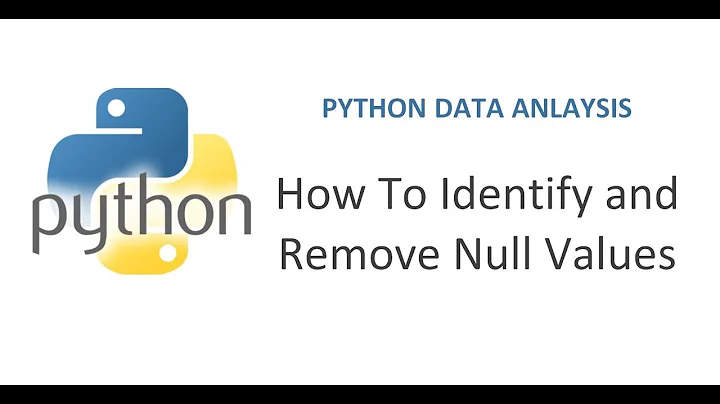Removing nan values from an array
Solution 1
If you're using numpy for your arrays, you can also use
x = x[numpy.logical_not(numpy.isnan(x))]
Equivalently
x = x[~numpy.isnan(x)]
[Thanks to chbrown for the added shorthand]
Explanation
The inner function, numpy.isnan returns a boolean/logical array which has the value True everywhere that x is not-a-number. As we want the opposite, we use the logical-not operator, ~ to get an array with Trues everywhere that x is a valid number.
Lastly we use this logical array to index into the original array x, to retrieve just the non-NaN values.
Solution 2
filter(lambda v: v==v, x)
works both for lists and numpy array since v!=v only for NaN
Solution 3
Try this:
import math
print [value for value in x if not math.isnan(value)]
For more, read on List Comprehensions.
Solution 4
For me the answer by @jmetz didn't work, however using pandas isnull() did.
x = x[~pd.isnull(x)]
Solution 5
@jmetz's answer is probably the one most people need; however it yields a one-dimensional array, e.g. making it unusable to remove entire rows or columns in matrices.
To do so, one should reduce the logical array to one dimension, then index the target array. For instance, the following will remove rows which have at least one NaN value:
x = x[~numpy.isnan(x).any(axis=1)]
See more detail here.
Related videos on Youtube
Dax Feliz
My name is Dax. I am an aspiring astrophysicist learning how to program for data purposes.
Updated on July 20, 2022Comments
-
Dax Feliz almost 2 years
I want to figure out how to remove nan values from my array. My array looks something like this:
x = [1400, 1500, 1600, nan, nan, nan ,1700] #Not in this exact configurationHow can I remove the
nanvalues fromx?-
smci almost 5 yearsTo be clear, by "remove NaNs" you mean filter out only the subset of non-null values. Not "fill the NaNs with some value (zero, constant, mean, median, etc.)"
-
-
Miki Tebeka almost 12 yearsOr
x = x[numpy.isfinite(x)] -
jmetz almost 12 yearsIf you're using numpy both my answer and that by @lazy1 are almost an order of magnitude faster than the list comprehension - lazy1's solution is slightly faster (though technically will also not return any infinity values).
-
chbrown over 10 yearsOr
x = x[~numpy.isnan(x)], which is equivalent to mutzmatron's original answer, but shorter. In case you want to keep your infinities around, know thatnumpy.isfinite(numpy.inf) == False, of course, but~numpy.isnan(numpy.inf) == True. -
jmetz over 10 years@dax-felizv I agree with @chbrown, NaN and Infinite are not the same in
numpy. @chbrown - thanks for pointing out the shorthand forlogical_not, though beware that it is considerably slower - stackoverflow.com/questions/15998188/…, stackoverflow.com/questions/13600988/… -
chbrown over 10 yearsHmm, @mutzmatron -- I figured they did the same thing underneath the hood, and I'm getting very similar results with timeit (as did @unutbu at that first link):
python -m timeit -s "import numpy; bools = numpy.random.uniform(size=10000) >= 0.5" "numpy.logical_not(bools)"vs.python -m timeit -s "import numpy; bools = numpy.random.uniform(size=10000) >= 0.5" "~bools"(numpy.__version__ == '1.8.0') -
jmetz over 10 years@chbrown - you're right, any performance gain with numpy seems to have only occurred on the second posters machine - I tested
numpy.invertandnumpy.logical_notand got the same result for both as for~, on numpy v1.7.1. Not sure if architecture affects comparative performance - am testing on my chromebook (armv7l). -
Austin Richardson almost 9 yearsA hack but an especially useful one in the case where you are filtering nans from an array of objects with mixed types, such as a strings and nans.
-
jmetz about 7 yearsThis is strange; according to the docs, boolean array indexing (which this is), is under advanced indexing which apparently "always returns a copy of the data", so you should be over-writing
xwith the new value (i.e. without the NaNs...). Can you provide any more info as to why this could be happening? -
 Pier Paolo almost 7 yearsWelcome to SO! The solution you propose does not answer the problem: your solution substitutes
Pier Paolo almost 7 yearsWelcome to SO! The solution you propose does not answer the problem: your solution substitutesNaNs with a large number, while the OP asked to entirely remove the elements. -
 BoltzmannBrain over 6 yearsFor people looking to solve this with an ndarray and maintain the dimensions, use numpy where:
BoltzmannBrain over 6 yearsFor people looking to solve this with an ndarray and maintain the dimensions, use numpy where:np.where(np.isfinite(x), x, 0) -
Moondra over 6 yearsVery clean solution.
-
hypers over 6 yearsDon't forget the brackets :)
print ([value for value in x if not math.isnan(value)]) -
towry almost 6 yearsTypeError: only integer scalar arrays can be converted to a scalar index
-
jmetz almost 6 years@towry: this is happening because your input,
xis not a numpy array. If you want to use logical indexing, it must be an array - e.g.x = np.array(x) -
Chris_Rands almost 6 yearsThis might seem clever, but if obscures the logic and theoretically other objects (such as custom classes) can also have this property
-
 yeliabsalohcin over 5 yearsIf you're using numpy like the top answer then you can use this list comprehension answer with the
yeliabsalohcin over 5 yearsIf you're using numpy like the top answer then you can use this list comprehension answer with thenppackage: So returns your list without the nans:[value for value in x if not np.isnan(value)] -
Dark about 4 yearsAlso, to completely remove the non-finite rows, use
.any(axis=1). The full code will bex=x[~pd.isnull(x).any(axis=1)]for Pandas orx=x[~np.isnan(x).any(axis=1)]for Numpy. Note that these are working on different type of variables. -
jmetz about 4 years@Dark - thanks for the useful example for 2d data, though it's beyond the scope of the OP's question which relates only to a 1d input. Perhaps it would be useful for others posted as a separate Q and A?
-
Christian O'Reilly almost 4 yearsAlso useful because it only needs
xto be specified once as opposed to solutions of the typex[~numpy.isnan(x)]. This is convenient whenxis defined by a long expression and you don't want to clutter the code by creating a temporary variable to store the result of this long expression. -
smm over 3 yearsIt might be slow compere to
x[~numpy.isnan(x)] -
 seralouk over 3 years
seralouk over 3 yearsx = x[~numpy.isnan(x)]is beautiful -
Darren Weber about 2 yearsSimilarly, as a list comprehension, e.g.
[v for v in var if v == v] -
Darren Weber about 2 yearsThis can avoid
TypeError: ufunc 'isnan' not supported for the input typeswhen the var contains mixtures ofnanand strings, as noted by @AustinRichardson


![[Pandas Tutorial] how to check NaN and replace it (fillna)](https://i.ytimg.com/vi/JJaLtI-6BT0/hqdefault.jpg?sqp=-oaymwEcCOADEI4CSFXyq4qpAw4IARUAAIhCGAFwAcABBg==&rs=AOn4CLCBSYaunluvyPFx6OZQJiLiBLuOmg)





